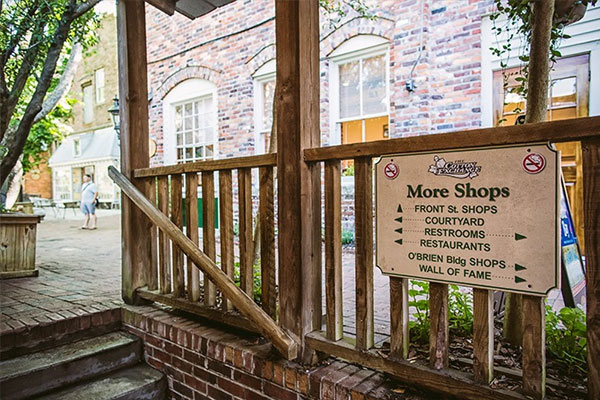The Cotton Exchange Experience
Shops, Services & Restaurants
Go on an adventure as you follow the winding brick corridors of the celebrated Cotton Exchange. You’ll journey through charming courtyards, adorned in antiques and beautiful landscapes. Located in historic downtown Wilmington, just minutes from the Battleship North Carolina and walking distance from downtown hotels, it’s a shopping experience like no other.
With storefronts reminiscent of a 19th century Southern city street, you’ll discover the best in dining, apparel, jewelry, home goods, fine arts, handcrafted items, toys, souvenirs and more! You’re sure to find a treasure at any one of our 20+ locally owned shops and boutiques. After some retail therapy, you’re only steps away from a relaxing stroll on the Riverwalk.
Visit Wilmington’s Walk of Fame
Located in the Walk of Fame Plaza at the Water Street entrance of The Cotton Exchange, visitors will find the Wilmington Walk of Fame. The Walk honors the people who have lived in the Cape Fear region and obtained national and international fame. Engraved stones set permanently into the walk immortalize local celebrities such as:
Trot Nixon, Major League Baseball player
Pat Hingle, movie actor
Charlie Daniels, singer and songwriter
David Brinkley, newscaster
Don Payne, The Simpson’s producer
Althea Gibson, tennis superstar
Roman Gabriel, NFL quarterback
Minnie Evans, artist
Henry Bacon, Lincoln Memorial designer
Frank Capra, Jr., filmmaker
Caterina Jarboro, opera singer
Meadowlark Lemon, Harlem Globetrotter
Visit Wilmington’s Walk of Fame
Located in the Walk of Fame Plaza at the Water Street entrance of The Cotton Exchange, visitors will find the Wilmington Walk of Fame. The Walk honors the people who have lived in the Cape Fear region and obtained national and international fame. Engraved stones set permanently into the walk immortalize local celebrities such as:
Trot Nixon, Major League Baseball player
Pat Hingle, movie actor
Charlie Daniels, singer and songwriter
David Brinkley, newscaster
Don Payne, The Simpson’s producer
Althea Gibson, tennis superstar
Roman Gabriel, NFL quarterback
Minnie Evans, artist
Henry Bacon, Lincoln Memorial designer
Frank Capra, Jr., filmmaker
Caterina Jarboro, opera singer
Meadowlark Lemon, Harlem Globetrotter
The Cotton Exchange History
Reflecting the charm and style of 19th Century Wilmington
Located in Downtown Wilmington, The Cotton Exchange is a stunning example of preservation of the Cape Fear region’s deep-rooted history in trade. Visitors will find themselves on a historical adventure as they visit the 30 unique specialty shops and restaurants housed within the eight-building complex. Joined by brick walkways and open-air courtyards, each building has been beautifully restored to reflect the charm and style of 19th Century Wilmington, when the port was a bustling center for trade around the world.
Constructed years before the Civil war, the Sprunt Building was home to the Cape Fear Flour and Pearl Hominy Mill in 1884. The mill was the largest in the South at its time. In 1919, the building would be repurposed to make room for another industry giant, Alexander Sprunt & Sons. Sprunt & Sons had massive success in the cotton export industry, becoming the biggest cotton company in the world. Delivering cotton to ports in Europe, England, and America, it’s Sprunt’s thriving shipping endeavors that earned “The Cotton Exchange” its name.
Enduring each era, The Cotton Exchange has a history of providing invaluable services to the residents of Southeastern North Carolina The Wood Seed Building was a Chinese Laundry in 1917, then in the 1930s it became E.C. Moore’s Wholesale Notion Company, which produced sewing supplies. By 1938, there was an increasing demand in the farming industry and the building was sold to T.W. Wood & Son’s Seed Company. Wood & Son shared the space with Winslow Merrick, a local barber, who catered to the railroad commuters and businessmen in need of a haircut.
Various other businesses have occupied the eight buildings of The Cotton Exchange; The Bear Building was a wholesale grocer in 1913, while in the 1930s, The O’Brien building housed the popular Sears, Roebuck & Company. The Granary Building located on Nutt Street formerly housed the Boney & Harper Milling Company, which in 1912 could produce 4,000 bushels a day of pearl hominy, grits, and cornmeal. In 1884, the Dahnhardt Building was a three-story mariner’s saloon until after a fire destroyed much of the building, W.B. Cooper took over and opened his wholesale grocery and peanut cleaning operation in 1900.
North Carolina’s first downtown complex to adapt & repurpose historic buildings.
By the 1970s, the once bustling railroad hub and the beautiful buildings of our port city had greatly deteriorated. Many industries had left when in 1961, the Railroad moved its headquarters to Florida. As a result, the Wilmington Redevelopment Commission began demolishing buildings to revitalize the area. Fortunately for The Cotton Exchange, by 1974, just as all eight buildings were scheduled for demolition, J.R. Reaves and M.T. Murray bought the property with a unique plan to preserve history, renovating the space and using it for retail shops and restaurants.
The Cotton Exchange opened its doors in 1976 and has offered its visitors a unique and exciting shopping adventure ever since.



